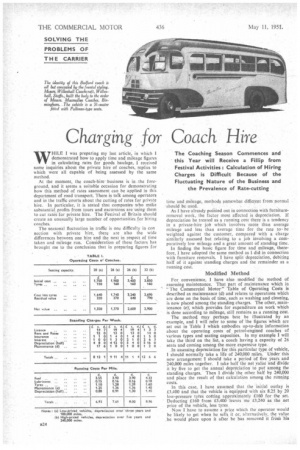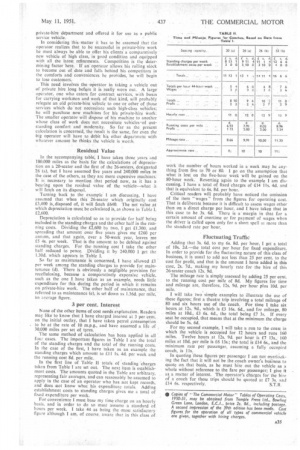Charging for Coach Hire
Page 58

Page 61

If you've noticed an error in this article please click here to report it so we can fix it.
The Coaching Season Commences and this Year will Receive a Fillip from Festival Activities : Calculation of Hiring Charges is Difficult Because of the Fluctuating Nature of the Business and the Prevalence of Rate-cutting
WHILE I was preparing my last article, in which I demonstrated how to apply time and mileage figures in calculating rates for goods haulage, I received some inquiries about the private hire of coaches, replies to which were all capable of being assessed by the same method.
At the moment, the coach-hire business is in the foreground, and it seems a suitable occasion for demonstrating how this method of rates assessment can be applied in this department of road transport. There is talk among operators and in the traffic courts about the cutting of rates for private hire. In particular, it is stated that companies who make substantial profits from tours and excursions are using them to cut rates for private hire. The Festival of Britain should create an unusually large number of opportunities for hiring coaches.
The seasonal fluctuation in traffic is one difficulty in con nection with private hire, there are also the wide differences between one hire and the next in respect of time taken and mileage run. Consideration of these factors has brought me to the conclusion that in preparing figures for time and mileage, methods somewhat different from normal should be used.
As I have already pointed out in connection with furnitureremoval work, the factor most affected is depreciation. If depreciation be treated as a running cost there is a tendency in a private-hire jOb which involves more than average mileage and less than average time for the rate to• be weighted against the customer, compared with a charge similarly assessed but relating to a job involving a comparatively low mileage and a great amount of standing time.
In finding the basic figure for time and mileage, therefore, I have adopted the same method as I did in connection with furniture removals. I have split depreciation, debiting half of it against standing charges and the remainder as a running cost.
Modified Method
For convenience, I have also modified the method of assessing maintenance. That part of maintenance which in "The Commercial Motor" Table of Operating Costs is described as maintenance (d) and relates to operations which are done on the basis of time, such as washing and cleaning, is now placed among the standing charges. The other, maintenance (e)-, which provides for expenditure on work which is done according to mileage, still remains as a running cost.
The method may perhaps best be illustrated by an example, and I will refer to some of the figures which are set out in Table I which embodies up-to-date information about the operating costs of petrol-engined coaches of various types and seating capacities. In my example I will take the third on the list, a coach having a capacity of 26 seats and coming among the more expensive type.
In assessing depreciation for this particular type Of vehicle, I should normally take a life of 240,000 miles. Under this new arrangement I should take a period Of five years and 240,000 miles together. I take half the net value and divide it by five to get the annual depreciation to put among the standing charges. Then I divide theother half by 240,000 and place the result of that calculation among the running costs.
In this case, I have assumed that the initial outlay is £3,400 and that the vehicle is equipped with six 8.25 by 20 low-pressure tyres coSting approximately £160 for the set. Deducting £160 from £3,400 leaves me £3,240 as the net price of the vehicle, less tyres
Now I have to assume a price which the operator would be likely to get when he sells it or, alternatively, the value he would place upon it after. he has removed it from his
private-hire department and offered it for use as a public service vehicle.
In considering this matter it has to be assumed that the operator realizes that to be successful in private-hire work he must always be able to offer his clients a comparatively new vehicle of high class, in good condition and equipped with all the latest refinements. Competition is the determining factor here. If an operator allows his rolling stock to become out of date and falls behind his ccimpetitors in the comforts and conveniences he provides, he will begin to lose customers.
This need involves the-operator in taking a vehicle out of private hire long before it is really worn out. A large operator, one who caters for contract services, with buses for carrying workmen and work of that kind, will probably relegate an old private-hire vehicle to one or other of those services which do not necessitate such high-class vehicles; he will purchase new machines for his private-hire Work: The smaller operator will dispose of his machine to another whose class of work does not necessitate vehicles-of outstanding comfort and modernity. So far as the present calculation is concerned, the result is the same, for even the big operator will have to debit his other department with whatever amount he thinks the vehicle is worth.
Residual Value
In the accompanying table, I have taken three years and 180.000 miles as the basis for the calculations of depreciation on a 20-seater and the first of the 26-seaters, designated 26 (a), but I have assumed five years and 240,000 miles in the case of the others, as they are more expensive machines. It is necessary to mention that period now, as it has a bearing upon the residual value of the vehicle--what it will fetch on its disposal.
Turning back to the example I am discussing, I have assumed that when this 26-seater which originally cost £3,400 is,disposed of, it will fetch £640. The net value At which depreciation must be calculated is, as shown in Table I, £2,600.
Depreciation is calculated so as to provide for half being included in the standing charges and the other half in the running costs. Dividing the £2,600 by two. I get £1.300, and spreading that amount over five years gives me £260 per annum, and that again, over a 50-week year, leaves me £5 4s. per week. That is the amount to be debited Against standing charges. For the running cost I take the other half reduced to pence. Dividing it by 240.000 I get the I.30d. which appears in Table I.
So far as maintenance is concerned, I have allowed £1 per week among the standing charges to provide for maintenance (d). There is obviously a negligible provision for recellulosing, because a comparatively expensive vehicle, such as the one I have taken as an example, needs little expenditure for this during the period in which it remains on private-hire work. The other half of maintenance, that referred to as maintenance (e), is set down as 1.36d. per mile, an average figure.
3 per cent. Interest
None of the other items of cost needs explanation. Readers may like to know that I have charged interest at 3 per cent. on the initial outlay, that I have taken petrol consumption to be at the rate of 10 m.p.g., and have assumed a life of 30,000 miles per set of tyres.
The same method of calculation has been applied in all four cases. The important figures in Table I are the total of the standing charges and the total of the running costs. In the case of the first, I have taken as an example the standing charges which amount to I 1 Is. 4d. per week and the running cost 8d. per mile.
In the first line of Table It totals of standing charges taken from Table I are set out. The next item is establishment costs. The amounts quoted in the Table are arbitrary. representing fair averages, and can reasonably be assumed to apply in the case of an operator who has not kept records, and does not know what his expenditure totals. Adding establishment costs to standing charges gives me a total of fixed expenditure per week.
For convenience I must base my time charge on an hourly basis, and in order to do so must assume a standard of hours per week. I take 44 as being the most satisfactory figure although I am, of course, aware that in this class of work the number of hours worked in a week may be anything from five to 70 or 80. I go on the assumption that what is lost on the five-hour week will be gained on the 80-hour week. Reverting again to the example I am discussing, I have a total of fixed charges of £14 I ls. 4d. and that is equivalent to 6s. 8d. per hour.
Critical readers will probably have noticed the omission of the item "wages" from the figures for operating cost. That is deliberate because it is difficult to assess wages other than on a direct charge per hour, and I have taken that in this case to be 3s. 6d. There is a margin in that for a certain amount of overtime or for payment of wages when the driver is called upon only for a short spell at more than the standard rate per hour.
Fluctuating Traffic
Adding that 3s. 6d. to my 6s. 8d, per hour, I get a total of 10s. 2d.-the total cost per hour for fixed expenditure. In order to provide for the fluctuating nature of this class of business, it is usual to add not less than 25 per cent, to the cost for profit, and that is the amount I have added in this case, 2s. 7d., making my hourly rate for the hire of this 26-seater coach 12s. 9d.
The mileage rate is simply assessed by adding 25 per cent. to the running cost per mile of 8d. My figures for time and mileage are, therefore. 12s. 9d. per hour plus 10d. per mile.
I will take two simple examples to illustrate the use of these figures; first a theatre trip involving a total mileage of 80 and six hours use of the coach. For time I take six hours at 12s. 9d., which is £3 16s. 6d.. and for mileage, 80 miles at 10d., £3 6s. 6d., the total being £7 3s. If every seat be occupied, that means that at the minimum the charge should be 5s. 6d.
For my second example, I will take a run to the coast in which the vehicle is occupied for 12 .hours and runs 160 miles. Twelve hours at 12s. 9d. per hour is £7 13s..' 160 miles at 10d. per mile is £6 13s.; the total is £14 6s., and the minimum rate per passenger, assuming a fully occupied coach, is I Is.
In quoting these figures per passenger I am not overlooking the fact that it will not be the coach owner's hilliness to quote on that basis, as he must hire out the vehicle as a whole without reference to the fare per passenger; I give it as a matter of interest. The operator's charges for the hire of a coach for these trips should be quoted at /7 3s. and £14 6s. respectively. S.T.R.




























































































